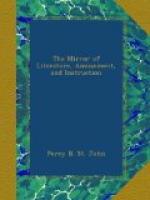* * * * *
When the celebrated Philip Henry was ejected from the establishment, Dr. Busby (who had been his tutor) meeting him, said, “Who made you a nonconformist?” “You, Sir,” replied he, “I made you a nonconformist!” “Yes, Sir, you taught me those principles which forbade to violate my conscience.”
TOSCAR.
* * * * *
THE SKETCH-BOOK.
* * * * *
ANTWERP CATHEDRAL.
(For the Mirror.)
Antwerp possesses considerable interest to an Englishman, as a place of great importance during the late war, when there was a sort of mystery attached to it, as the secret grand naval depot of Napoleon, which our Government thought to “cripple France for ever,” by getting into our own hands! But what the Earl of Chatham, with an army of twenty thousand men, aided by a fine British fleet, could not do, I did: I made my entry into Antwerp—without molestation, thanks to the benign Spirit of Peace—towards the evening of a fine day in July; and while the impression of novelty was still fresh, enjoyed a rich treat in viewing its noble Cathedral. The interior is grand, but simple—striking the beholder more by its loftiness and spaciousness, than by any profusion of glittering ornament, so common in Catholic churches—although the forest of pillars, the altar-piece, the statues, and above all the splendid pictures which grace the walls, form a rich variety to the eye. It would be useless to enter into a minute detail, for no description can give a stranger a perfect idea of one building distinct from others of a similar kind, and those who have seen the object itself do not require it. Antwerp may be called the country of Rubens: at every turn you meet with monuments of his genius; and here (in the Cathedral) you have what is esteemed his masterpiece—the “Descent from the Cross”—which surprises you with a boldness of drawing, vigour and richness of colouring, and an animation in the grouping, that can scarcely be excelled; and when you discern the colossal figures from a little distance amongst the pillars and arches of the nave, you feel inclined to bow in reverence to the divinity of the genius which has portrayed so wonderful a conception of the mind. It is needless to say that this was one of the works of art carried to Paris to enrich the gallery of the Louvre, together with one placed in a corresponding situation, “The Assumption of the Virgin,” which is more in Rubens’ florid style than the former. There is also, by the same master-hand, a noble picture, “The Elevation of the Cross,” in the artist’s happiest manner; and the exquisite altarpiece, “The Ascension,” is also his work. There are several other fine paintings here—one of them said to be the best performance of Quintin Matsys, who, under the inspiration of love, deserted the anvil




